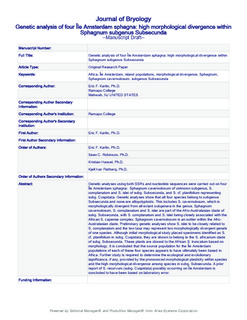| dc.contributor.author | Karlin, Eric F. | |
| dc.contributor.author | Robinson, Sean C | |
| dc.contributor.author | Hassel, Kristian | |
| dc.contributor.author | Flatberg, Kjell Ivar | |
| dc.date.accessioned | 2019-08-14T09:06:42Z | |
| dc.date.available | 2019-08-14T09:06:42Z | |
| dc.date.created | 2018-09-13T11:34:28Z | |
| dc.date.issued | 2018 | |
| dc.identifier.citation | Journal of Bryology. 2018, 40 107-119. | nb_NO |
| dc.identifier.issn | 0373-6687 | |
| dc.identifier.uri | http://hdl.handle.net/11250/2608234 | |
| dc.description.abstract | This study uses microsatellites (SSRs) and nucleotide sequences to explore unresolved questions associated with four of the six Sphagnum species reported for Île Amsterdam: Sphagnum cavernulosum of unknown subgenus, S. complanatum and S. islei of subg. Subsecunda, and plants that initial morphological study placed in subg. Cuspidata. Genetic analyses show that all four species belong to subgenus Subsecunda and that none are allopolyploids. The plants initially placed in subg. Cuspidata are shown to belong to the ‘S. africanum’ clade of subg. Subsecunda and are closest to the African S. truncatum based on morphology. Sphagnum cavernulosum, S. complanatum, and S. islei are part of the Afro-Australasian clade of subg. Subsecunda, with S. complanatum and S. islei being closely associated with the African ‘S. capense’ complex and S. cavernulosum, which is morphologically divergent from all extant subgenera in the genus, being an outlier within this clade. Preliminary genetic analyses show S. islei to be closely related to S. complanatum and that they may represent two morphologically divergent genets of one species. The ancestral origins for the Île Amsterdam populations of S. complanatum, S. islei, and S. cf. truncatum are each ultimately based in Africa. Further study is required to determine the ecological and evolutionary significance, if any, provided by the pronounced morphological variation within species and the high morphological divergence among species in subg. Subsecunda. Finally, a prior report of S. recurvum (subg. Cuspidata) possibly occurring on Île Amsterdam is concluded to have been based on laboratory error. | nb_NO |
| dc.language.iso | eng | nb_NO |
| dc.publisher | Taylor & Francis | nb_NO |
| dc.title | Genetic analysis of four Île Amsterdam sphagna: high morphological divergence within Sphagnum subgenus Subsecunda | nb_NO |
| dc.type | Journal article | nb_NO |
| dc.description.version | submittedVersion | nb_NO |
| dc.source.pagenumber | 107-119 | nb_NO |
| dc.source.volume | 40 | nb_NO |
| dc.source.journal | Journal of Bryology | nb_NO |
| dc.identifier.doi | 10.1080/03736687.2018.1448502 | |
| dc.identifier.cristin | 1609138 | |
| dc.description.localcode | This is an [Original Manuscript] of an article published by Taylor & Francis in [Journal of Bryology] on [20 Apr 2018], available at https://doi.org/10.1080/03736687.2018.1448502 | nb_NO |
| cristin.unitcode | 194,31,10,0 | |
| cristin.unitname | Institutt for naturhistorie | |
| cristin.ispublished | true | |
| cristin.fulltext | preprint | |
| cristin.qualitycode | 1 | |
